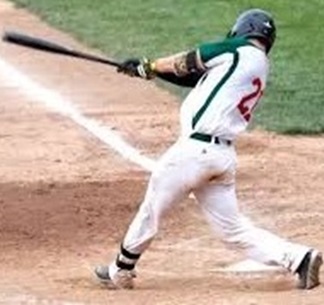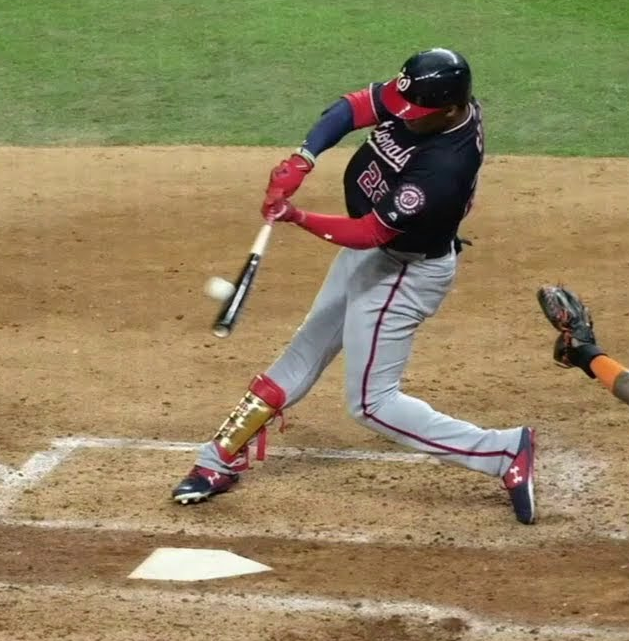Batting Is Like Jumping …how to generate greater bat speed and power
/Note: this article touches on a couple other aspects of the swing beyond the leg action. Those aspects are not explained in detail. Each aspect of the swing is addressed in other Baseball Positive articles and videos. Please let me know in the comments section if this article creates more questions than answers. I will reply and try to provide some clarification.
The Legs Initiate and Power the Swing
The energy for power and bat speed in the swing is generated in the legs. When the legs are fully utilized, the initial action in the batting swing is much like Jumping.
When a person jumps, they squat down, swing their arms back, then with a quick burst of energy, extend their legs while accelerating their arms straight- up. The first sections of this article describe the basic actions that create energy to produce a quick and powerful swing.
At the end of this article, I share a very simple drill to help a young batter develop their ability to maximize the use of their legs in their swing. All the information presented prior to the drill is meant to give some background on why this very simple drill is so important for a youth baseball or softball player to practice.
HOW POWER FROM THE LEGS IS MAXIMIZED IN THE SWING
The action of the legs when swinging a bat is very much like jumping. The primary difference is jumping takes place on a vertical plane, while the batting swing takes place on a horizontal plane.
The other difference is a batter doesn’t fully extend their legs (back leg to be specific) in the swing as happens in the jumping action.
In the swing, a batter ANCHORS their back leg, which stops their leg extension mid-‘jump’.
The ‘stopping’ of the ‘jump’ is a key to transferring energy and momentum from the legs to the hands. (Anchor is discussed further down).
WEIGHT SHIFT
The shifting of body weight in the swing is fairly subtle; there is much less movement in the weight-shift action than many people think - or teach. Reference to weight shift when working with kids is giving more info than they need at this early point in their development. Chances are good they will misinterpret this information to their detriment. Keeping the teaching focus on use of the legs, leg turn, balance and body control is more than sufficient.
In a ‘traditional’ stance, and in many of the stances we see at the professional level, the batter starts with their weight pretty much evenly distributed between their feet. Their torso and head are centered between their feet. Some batters have a little extra weight on their back foot/leg.
From this Centered and Balanced position, the batter shifts their weight slightly to their back leg - The Load
(The phrase ‘Turn Back’ is preferable to ‘Load’ when working with kids. It is important that we recognize, in all our coaching communication, that kids have a smaller vocabulary than adults and have had less exposure to the terms associated with the game. Many don’t know exactly what is meant by the term ‘Load’. The phrase, ‘Turn Back’ is a literal description of the loading action. When loading, a batter makes a slight inward Turn of their front knee and/or shoulder along with the slight weight shift Back.)
From the loaded (‘back’) position, the batter shifts their weight forward, to where their weight is, again, centered between their feet ...not forward (past center) to their front foot. A teaching phrase we use in Baseball Positive instruction is ‘centered’. During the instruction process, the constant use of the phrases/terms of ‘Turn back, Turn fast’ and centered evolve to our batter developing a solid ‘back to centered’ weight shift, without getting into the weeds of incorporating the addition instruction/information of ‘weight shift’ as mentioned earlier.
In the 80’s, a more dramatic forward weight shift was taught by some high-level coaches; this trickled down to the youth level. This is still in use today to some extent. My observation is this focus on weight shift produces more harm than good for most kids eagerly trying to learn and please their coach.
In previous decades the stride was taught; this continued through the end of the century. Today, the vast majority of MLB batters do not stride.
Other Baseball Positive articles address the Stride and Leg Turn action in more detail
The weight shift is from ‘back to center’, involving a minimal amount of forward movement.
It is during this slight movement, from back to center, that the batter is ‘Jumping’. While it takes place in a small space, through this action a batter is fully utilizing the strength in their legs to generate power and energy for the swing. Many youth players are unaware of the importance of the legs in the swing and few, if any, are trained to maximize their legs in their swing.
The following information gives some basics on how the swing works. This information builds off the points made earlier in this article.
ANCHORING THE SWING
The action of anchoring the swing has the batter driving the muscles of their back leg straight down against their back knee. This driving down action takes place as the batter is turning their legs/hips,
A teaching phrase used constantly in Baseball Positive instruction is ‘Turn Fast’ - said with a lot of energy and emphasis. Because most kids are not aware of the importance of their legs in the swing, or that the legs have anything to do with the swing at all, it is critical that we constantly talk ‘legs’. When we teach, we want to put extra emphasis on our statements referring to the use of the legs.
The down drive of the back-leg muscles against the back knee is what ANCHORS the swing (prevents too much forward movement).
I have players do a drill with their hands on their hips, then give the command ‘Turn Back, Turn Fast’. This is a drill we want kids doing constantly throughout their youth playing careers.
When the teaching focus is on Anchoring the Swing, I have them hold the finish position, then firmly run a hand down the side of their leg, so they get a ‘feel’ for driving down with the muscles of their back leg. ‘Feel’ is an important part of learning muscle movements.
At the end of the Leg/hip turn, the lower half of the body ‘stops’ right in the middle of the swing. When the Legs/hips stop, the energy they produced has to go somewhere …it is transferred to the hands…this energy transfer is a key to maximum bat speed and power. If you watch a super slo-mo video of the swing, in most cases, you can see the lower half of the body (legs/hips) literally stop (watch the two videos below).
Javy Baez watch 1:05-1:15 …specifically note: 1:07-1:12
Alex Bregman watch 0:22-0:37
THE LEGS POWER THE HANDS IN A STRAIGHT LINE
The hands take the energy and momentum created by the legs to accelerate the bat to the ball. The path of the hands in the swing, to and through contact, is a straight line (more or less).
The bottom hand ‘pulls’ the bat ‘half way’ towards contact point. The bottom hand ‘stops’ (is finished contributing to the swing) midway through the aspect of the swing involving the hands.
The top hand then snaps ‘all the way’, using a ‘skipping-a-rock’ action where the palm of the top hand is facing up through contact.
Note: the action of the hands in the ‘swing’ is not a circular, as one might think, but more of a straight line. An efficient hitter doesn’t ‘swing’ the bat, they ‘snap’ the bat.
DRILL - ‘DEEP LOAD’
This is a modified version of the ‘Switch Heels’ drill shown earlier. When the batter Turns Back we have them exaggerate this action by turning back a bit more than usual and sinking their butt a bit resulting in Deeper knee bend then normal.
From this Deep Load position, the batter Turns Fast and ‘Jumps’ to the ANCHOR position …and completes their swing. This is all one continuous action from stance to the completion of the swing.
The drill is executed while working off a tee, doing soft toss (watch this video), or short front toss (see pictures Batting Practice, A 12-plyer Drill)
The ‘Deep Load’ is the key point of the drill. In executing the deep load, the batter becoming aware of using their legs in the swing (simply gaining awareness of their legs is a ‘win’ in the learning process). Over time they will gain a sense of the feel of fully utilizing the legs in their swing.
When working with smaller and younger players it is important to recognize that they have limited strength in their legs and we are asking them to perform an action they have never done before. They will not master this the first time they try the drill….or the second time, or the third time. It is important to understand, when working with youth baseball and softball players, they are not going to ‘get it’ as fast as we want them to. In all our teaching, when working with young players, we must be patient with them…and with ourselves.
The loading action, as described earlier, involves a slight weight shift back while the front side of the body and/or front knee ‘turns in’ slightly. When turning back, the front heel comes off the ground.
(STRIDE is not mentioned in this article. Watch MLB batters; very few stride. Many simply ‘Turn Back’ as described. Some pick up their front foot and set it right back down. - I don’t teach stride and I encourage youth coaches to avoid talking about striding to kids age 12 and under. When they get to their teens, there will be a few kids who can benefit from incorporating a small stride into their swing.)
Prior to doing the drill we want to prep the batter with a brief explanation of the concept that the legs initiate the swing action and that the legs are where the power and energy of the swing is generated.
The info presented earlier in this article provides some talking points. The age of the batter dictates how deep the conversation will be. In any case, this prep talk should not take more than about 30 seconds. We want to give the batter just enough info, so they understand how to do the drill, then we want to get them working.
After they have taken some swings (10-15) their muscles will need a brief break. During the break, we can give them a little more insight about the importance of utilizing the legs in the batting swing.
RESULTS
This, like most drills, is not going to magically make a batter a superstar overnight. This is an activity to include in a swing workout. Over the course of time, the batter’s muscles will become trained to better utilize their legs, which will produce more power and bat speed.
Note: it is important, when working with an athlete of any age, to limit the volume of information we give them at any one time. This is an easier strategy to follow if we go into the teaching session with the understanding that we are not going to see miraculous improvements in just a few minutes. The process of learning and improving muscle actions in athletes is a days, weeks, and in some instances, months-long proposition.










